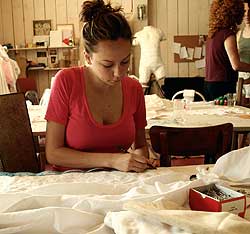In 1994, dancer Liz Claire, Ph.D., then a junior in the Performing Arts Department (PAD) in Arts & Sciences, won the Bemis Summer Travel Scholarship. The award allowed her to travel to Paris as an intern with David Dorfman Dance, the internationally acclaimed company founded some years before by alumnus David Dorfman.
“I saw David perform several solos, touching on issues of masculinity, Jewish identity, personal faith, human cruelty, human vulnerability, fear and love,” Claire said. “I was transformed by those performances.”

After graduating in 1995, Claire moved to New York City and continued studying with Dorfman. She also began performing with PearsonWidrig DanceTheater and earned both a master’s degree and doctorate in performance studies from New York University.
Today, both Claire and Dorfman, in different ways, continue to make their marks on Washington University.
This weekend, David Dorfman Dance will present “underground,” an ambitious evening-length multimedia piece loosely inspired by the Weather Underground, as part of the Edison Theatre OVATIONS Series.
Meanwhile, Claire is founder and director of MADE (Movement Arts & Design in Europe) in France, an immersive summer study abroad program that is sponsored by the PAD with additional support from Connecticut College, where Dorfman teaches.
Like the PAD’s popular Shakespeare’s Summer Globe Program, the six-credit course — which recently completed its second year — combines intensive performance training with careful study of history and culture.
“MADE in France offers a hands-on historical survey of European art, dance and costume design,” said Claire, who also teaches dance history at the Ecole des Hautes Etudes en Sciences Sociales in Paris. “Our hope is that students will learn how to move from research in performance history to creative praxis, articulating, rendering and transforming their ideas into concrete inventions.
“We also want students to acquire life skills: about travel and living in a foreign country; about cultural and artistic exchange; about cooperation with peers; about representing their heritage as cultural ambassadors; about expanding their own creativity; and about how to make decisions in complex and unfamiliar situations,” Claire said.
The 2009 studio began last May, when 18 students from across the United States gathered in Paris for two weeks of field research. Led by Claire and designer Bonnie Kruger, senior lecturer and costume director in the PAD, participants attended performances and visited museums and other cultural institutions, including backstage tours of the Paris Opera’s Ecole de danse and set and costume design facilities at the Bastille.
“We introduce students to the notion of dramaturgical research for the movement arts,” Claire said, which in turn helps strengthen critical and analytic skills.
“We teach basic principles of design and construction for the stage, and we provide the opportunity for students to deepen their own practice in choreography, design and performance,” she said.
Following its Paris stay, the class traveled to the rural town of Melisey in the Burgundy region of France for a series of workshops and master classes exploring the ways choreography and visual design combine to form “a total theatrical experience,” Claire said.
Faculty consisted of both dancers and designers, including Dorfman and Kruger (who will attend every other year, alternating with the PAD’s David Marchant, senior lecturer in dance). Other faculty included Lisa Race, assistant professor of dance at Connecticut College, and set designer Henri Ogier, who recently worked on Dorfman’s “Disavowal,” an interactive dance/performance inspired by the abolitionist John Brown.
“It is important for dance students to have training in the visual arts because dance is not only a kinetic form of expression,” Claire said, adding that in France, cooperation between visual artists and choreographers dates to the 19th century.
“Questions about line, shape, color, texture, contrast, depth, light, sound, time and movement — the building blocks of visual art and design — also are questions for the choreographer,” she said. “Students too rarely have the time to explore these questions in both the static and the live dimensions. In our program, the collaboration between designers and dancers aims for such depth in the research.
“Ultimately, the performing arts are collaborative. MADE in France, inspired by the French tradition, puts this collaboration between the visual and movement arts at the core of the learning process,” Claire said.
For more information about the study abroad program, visit made-in-france.us or padarts.wustl.edu.
“underground” will be performed at 8 p.m. Friday and Saturday, Sept. 25 and 26, at Edison Theatre. For more information, call the box office at 935-6543 or visit edisontheatre.wustl.edu.